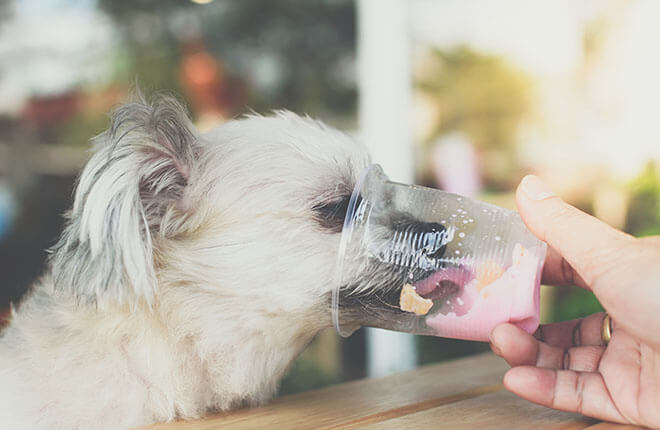You scream, I scream, we all bark for ice cream! When the weather turns hot, treat your furry friend to a frosty treat. This homemade ice cream for dogs recipe is easy to make and only uses ingredients that are safe for your pup.

You’ll notice one ingredient that’s missing in this dog ice cream recipe — milk. Although puppies drink milk, after weaning dogs no longer produce the enzyme needed to break down the lactose in cow’s milk and other dairy-based products. Dairy products can also be high in fat and sugar, which can cause gastrointestinal upset. As an alternative, we suggest using kefir or plain fat-free Greek yogurt (as long as they do not include artificial sweeteners like xylitol, which are toxic to your pets). Blend or mix in some of their favorite snacks, but be sure to avoid dangerous foods such as chocolate, coffee or espresso beans, and macadamia nuts when creating this delicious mouthwatering treat.
Ingredients
- 32 oz plain fat-free Greek yogurt or Kefir
- 2 ripe bananas (you can also sub in or add blueberries, apple without the core or seeds, watermelon, pumpkin, or fresh or natural peanut butter)
Instructions
- Blend together the yogurt or kefir with the add-ins of your choice, using a blender. If mixing by hand, the consistency will be less smooth, but your dog won’t mind (we promise).
- Line a 9 x 9” baking dish with parchment paper and spread the yogurt mixture in evenly. At this step, you can top with some complementing fruit.
- Freeze for 3-4 hours until the mixture has fully hardened.
- Lift the frozen block out of the pan and peel off the paper.
- Cut into suitable sized squares using a sharp knife.
- Store in freezer for the summer, with a maximum time shelf life of 2 months.
- Serve as cubes to your dog or let them thaw a bit in their bowl for a soft served ice cream treat.
This article contains recipe information that is considered suitable for pets. However, not all pets can tolerate different foods — it depends on their age, health history, and health conditions. It is important to consult with your veterinarian before feeding your pet any new foods or offering your pet any of the ingredients contained in this recipe.
ZPC-01360R1



